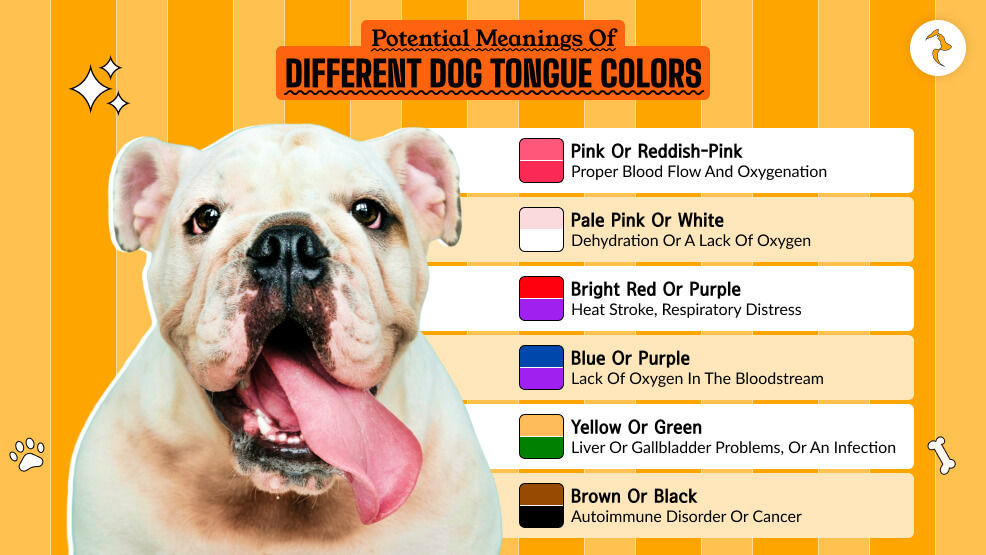Why Dog Tongue Color Matters: The Importance of Monitoring Your Pup’s Health


As a devoted dog parent, you know that your top priority is your furbaby’s overall well-being. But did you know that the color of your pup’s tongue can actually tell you a lot about their health? That’s right!
From pale pink to deep purple, your dog’s tongue color can be a window into their overall well-being. In this article, we’re going to dive into why monitoring your dog’s tongue color is so important and what different shades might mean for your furry friend’s health. So, grab a treat, call your pup over, and let’s get started!
The Role of a Dog’s Tongue in Their Overall Health

While you may be familiar with monitoring their energy levels, appetite, and behavior, have you ever considered that your dog’s tongue can provide valuable insights into your dog’s overall health? This is because this organ plays a crucial role in various bodily functions, including:
- Tasting and consuming food
- Lapping up water to stay hydrated
- Panting to regulate body temperature
- Grooming and cleaning themselves
Given its multifaceted purpose, a healthy tongue is essential for your dog’s optimal functioning. By understanding the connection between tongue color and potential health issues, you can take proactive steps to ensure your pup’s well-being.
Understanding the Significance of Dog Tongue Color

Just like humans, a dog’s tongue color can reveal a wealth of information about their internal health. While a healthy dog’s tongue is typically a shade of pink or reddish-pink, deviations from this norm can signify underlying conditions that require attention.
Monitoring your dog’s tongue color can help detect:
- Dehydration or heat stress
- Infections or inflammation
- Respiratory issues
- Circulatory problems
- Organ dysfunction
By being attentive to changes in your pup’s tongue color, you can identify potential health concerns early on and seek prompt veterinary care if necessary.
Potential Meanings of Different Dog Tongue Colors

To better understand the significance of your dog’s tongue color, let’s explore the various shades and their potential implications:
- Pink or Reddish-Pink: This is the ideal, healthy color for a dog’s tongue. It indicates proper blood flow and oxygenation.
- Pale Pink or White: A pale or whitish tongue can be a sign of anemia, shock, or poor circulation. It may also indicate dehydration or a lack of oxygen.
- Bright Red or Purple: An excessively red or purple tongue can signify various issues, such as heat stroke, respiratory distress, or an underlying heart condition.
- Blue or Purple (Cyanosis): A blue or purple tinge to the tongue can indicate a lack of oxygen in the bloodstream, which is a medical emergency.
- Yellow or Green: A yellow or greenish tongue may indicate liver or gallbladder problems, jaundice, or an infection.
- Brown or Black: While some dog breeds may naturally have darker tongues, a sudden change to a brown or black color can be a sign of a serious condition, such as an autoimmune disorder or cancer.
It’s important to note that these colors are not definitive diagnoses but rather indicators that something may be amiss. If you notice any concerning changes in your dog’s tongue color, it’s best to consult with your veterinarian promptly.
How to Use a Dog Tongue Color Chart for Monitoring Your Pup’s Health

To help you stay on top of your dog’s tongue color and potential health concerns, consider using a dog tongue color chart. These handy visual guides provide a reference for different tongue colors and their potential meanings, making it easier to identify any deviations from the norm.
You can find dog tongue color charts online, specifically websites offering pet care resources. Some veterinary clinics may also provide these charts for pet owners. By having a visual reference, you can more accurately monitor your pup’s tongue color and take appropriate action if needed.
When to Be Concerned About Your Dog’s Tongue Color

While some tongue color changes may be temporary or harmless, there are instances when you should be particularly vigilant:
- Sudden or drastic changes in tongue color
- Persistent discoloration lasting more than a day or two
- Accompanying symptoms such as lethargy, loss of appetite, or difficulty breathing
If you notice any of these concerning signs, it’s crucial to seek veterinary attention promptly. Early intervention can often prevent minor issues from escalating into more serious health problems.
Other Factors to Consider for Monitoring Your Pup’s Health

While tongue color is an important indicator of your dog’s health, it’s not the only factor to consider. A comprehensive approach to monitoring your pup’s well-being should also include:
- Regular Veterinary Check-ups: Routine visits with your veterinarian allow for thorough examinations, necessary vaccinations, and early detection of potential health issues.
- Monitoring Behavior and Appetite: Changes in your dog’s energy levels, appetite, or behavior can signal underlying health concerns.
- Observing Bodily Functions: Pay attention to your dog’s bowel movements, urination habits, and respiratory patterns for any irregularities.
- Grooming and Coat Condition: A dull, dry coat or excessive shedding may indicate nutritional deficiencies or other health problems.
By taking a holistic approach and being attentive to various aspects of your dog’s health, you can better identify potential issues and take appropriate action.
The Importance of Regular Veterinary Check-ups

While monitoring your dog’s tongue color and overall health at home is essential, it’s crucial to maintain regular veterinary check-ups. Your trusted veterinarian has the expertise and resources to conduct thorough examinations, interpret any concerning symptoms, and provide personalized recommendations for your pup’s well-being.
During these visits, your veterinarian may:
- Perform a physical examination, including checking your dog’s tongue color and oral health.
- Order diagnostic tests, such as blood work or imaging, if necessary.
- Recommend preventative care measures, such as vaccinations or parasite control.
- Provide guidance on nutrition, exercise, and other aspects of your dog’s care.
By establishing a strong relationship with your veterinarian and following their professional advice, you can ensure your furry companion receives the best possible care throughout their life.
As a caring dog owner, prioritizing your pup’s health should be at the forefront of your mind. By monitoring your dog’s tongue color and overall well-being, you can catch potential issues early and take proactive steps to ensure their happiness and longevity. If you notice any concerning changes in your dog’s tongue color or health, don’t hesitate to schedule an appointment with your trusted veterinarian. Their expertise and guidance can provide peace of mind and help keep your furry companion healthy for years to come.








Leave A Comment